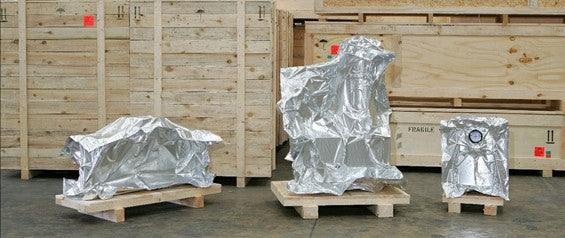
Why you should use barrier foil!
Barrier foil is the best way to package products to avoid corrosion during transport and storage. Corrosion can happen as long as you have moisture and oxygen - by vacuum packing with foil you remove the oxygen and thus stop the corrosion. Easy, huh?

It does require a bit more work at first, but with experience it goes faster and faster. If you have expensive equipment, it is definitely worth taking care of it! Equipment that is to be transported through different climates, temperatures and various stresses, e.g. from production in northern Norway to a shipyard in Thailand, MUST be packed well to arrive as well as it was when it left the port in Norway. In that case, barrier foil will often be the best choice.
All materials let moisture through - it's just a matter of time. The moisture penetration figure for barrier foil is approximately 0.05. In comparison, 200my plastic has a moisture penetration figure of 0.2. This means that even without a vacuum, the foil will protect much longer than normal plastic does.

To remove the humidity that was present during packing, a bag is used
with silica gel which is sealed inside the foil together with the equipment. Then you are sure that the product is completely dry.
How do you use barrier foil?
What you need to vacuum pack in barrier foil are three things:
-
Barrier foil , we have " regular " and reinforced

-
Welding pliers , We have several models in the range, both pliers and table models for smaller tasks

-
Vacuum cleaner

You start by cutting the barrier foil into areas that are slightly larger than the products you are going to package. The product is placed on the bottom of the barrier foil, then you cut to the sides and the lid. All the surfaces are then welded together with the welding tongs. When you have reached the last weld, leave a small hole where you insert the vacuum cleaner to create a vacuum. The hole is welded when you pull the vacuum cleaner out. If you do not get a vacuum, the seal is not tight and must be checked. If the foil hangs loose after transport, it has been punctured along the way.
If you want to have control over the humidity inside the barrier, you can fit a humidity indicator clock, similar to the one we use on the storage bins for silica gel. You will then see how high the humidity is inside the barrier. It can be a useful tool if the products are to be on standby in stock, for example.
With silica gel inside the barrier, moisture indicator and vacuum, you will have protection that lasts for many years, much longer than what other corrosion protection can provide. Your product will look as good as the day it was packed!

